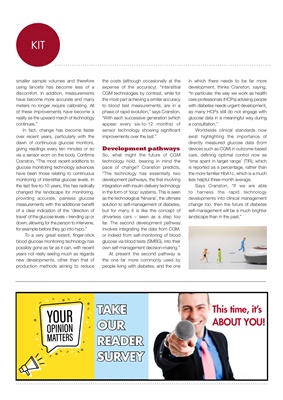
KIT
TAKE
OUR
READER
SURVEY
This time, it's
ABOUT YOU!
smaller sample volumes and therefore
using lancets has become less of a
discomfort. In addition, measurements
have become more accurate and many
meters no longer require calibrating. All
of these improvements have become a
reality as the upward march of technology
continues."
In fact, change has become faster
over recent years, particularly with the
dawn of continuous glucose monitors,
giving readings every ten minutes or so
via a sensor worn on the body. Confirms
Cranston, "The most recent additions to
glucose monitoring technology advances
have been those relating to continuous
monitoring of interstitial glucose levels. In
the last five-to-10 years, this has radically
changed the landscape for monitoring,
providing accurate, painless glucose
measurements with the additional benefit
of a clear indication of the 'direction of
travel' of the glucose levels - trending up or
down, allowing for the person to intervene,
for example before they go into hypo."
To a very great extent, finger-stick
blood glucose monitoring technology has
possibly gone as far as it can, with recent
years not really seeing much as regards
new developments, other than that of
production methods aiming to reduce
the costs (although occasionally at the
expense of the accuracy). "Interstitial
CGM technologies by contrast, while for
the most part achieving a similar accuracy
to blood test measurements, are in a
phase of rapid evolution," says Cranston,
"With each successive generation (which
appear every six-to-12 months) of
sensor technology showing significant
improvements over the last."
Development pathways
So, what might the future of CGM
technology hold, bearing in mind the
pace of change? Cranston predicts,
"The technology has essentially two
development pathways, the first involving
integration with insulin-delivery technology
in the form of 'loop' systems. This is seen
as the technological 'Nirvana', the ultimate
solution to self-management of diabetes,
but for many it is like the concept of
driverless cars - seen as a step too
far. The second development pathway
involves integrating the data from CGM,
or indeed from self-monitoring of blood
glucose via blood tests (SMBG), into their
own self-management decision-making."
At present the second pathway is
the one far more commonly used by
people living with diabetes, and the one
in which there needs to be far more
development, thinks Cranston, saying,
"In particular, the way we work as health
care professionals (HCPs) advising people
with diabetes needs urgent development,
as many HCPs still do not engage with
glucose data in a meaningful way during
a consultation."
Worldwide clinical standards now
exist highlighting the importance of
directly measured glucose data (from
devices such as CGM) in outcome-based
care, defining optimal control now as
'time spent in target range' (TIR), which
is reported as a percentage, rather than
the more familiar HbA1c, which is a much
less helpful three-month average.
Says Cranston, "If we are able
to harness the rapid technology
developments into clinical management
change too, then the future of diabetes
self-management will be a much brighter
landscape than in the past."